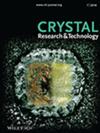用四硫钼酸铵在氮化镓上合成MoS2层的异质结器件
IF 1.9
4区 材料科学
Q3 CRYSTALLOGRAPHY
引用次数: 1
摘要
二维材料如硫化钼(MoS2)与传统半导体的集成导致了具有关键电学和光电子特性的新型异质结的制造。本文报道了一种在化学气相沉积(CVD)工艺中使用四硫钼酸铵(ATM)作为前驱体,而不是使用氧化钼前驱体,在晶格匹配的ga -极性氮化镓(GaN)晶片上生长MoS2晶体的方法。在独立的ga -极性GaN衬底上获得了单向三角形MoS2晶体和连续薄膜。此外,利用X射线光电子能谱研究了合成的MoS2晶体与GaN晶片的界面质量。结果表明,使用含氨的ATM前驱体可以得到质量较好的界面,界面处的表面氧明显较少。利用合成的MoS2层在GaN上制备了异质结器件,具有优异的整流二极管特性和光照下的光伏作用。该研究揭示了含氨ATM前驱体在CVD工艺中在GaN上生长MoS2晶体以获得适合器件应用的异质结构的适用性。本文章由计算机程序翻译,如有差异,请以英文原文为准。
Synthesis of MoS2 Layers on GaN Using Ammonium Tetrathiomolybdate for Heterojunction Device Applications
2D materials such as molybdenum sulfide (MoS2) integrated with conventional semiconductors lead to the fabrication of novel heterojunctions with pivotal electrical and optoelectronic properties. Herein, an approach is reported which addresses the growth of MoS2 crystals on the lattice‐matched Ga–polar gallium nitride (GaN) wafer using ammonium tetrathiomolybdate (ATM) as a precursor in a chemical vapor deposition (CVD) process, instead of using the molybdenum‐oxide‐based precursors. Unidirectional triangular MoS2 crystals and continuous film are obtained on the free‐standing Ga–polar GaN substrate. Further, the interface quality of the as‐synthesized MoS2 crystals and GaN wafer is explored by X‐ray photoelectron spectroscopy. It is observed that a good quality interface can be obtained by using the ammonia‐containing ATM precursor, where the surface oxygen at the interface is significantly less. A heterojunction device is fabricated with the synthesized MoS2 layer on GaN, showing excellent rectifying diode characteristics and a photovoltaic action with light illumination. This study reveals the suitability of the ammonia‐containing ATM precursor for the growth of MoS2 crystals on GaN in the CVD process to obtain a suitable heterostructure for device applications.
求助全文
通过发布文献求助,成功后即可免费获取论文全文。
去求助
来源期刊
自引率
6.70%
发文量
121
审稿时长
1.9 months
期刊介绍:
The journal Crystal Research and Technology is a pure online Journal (since 2012).
Crystal Research and Technology is an international journal examining all aspects of research within experimental, industrial, and theoretical crystallography. The journal covers the relevant aspects of
-crystal growth techniques and phenomena (including bulk growth, thin films)
-modern crystalline materials (e.g. smart materials, nanocrystals, quasicrystals, liquid crystals)
-industrial crystallisation
-application of crystals in materials science, electronics, data storage, and optics
-experimental, simulation and theoretical studies of the structural properties of crystals
-crystallographic computing

 求助内容:
求助内容: 应助结果提醒方式:
应助结果提醒方式:


